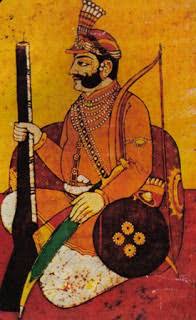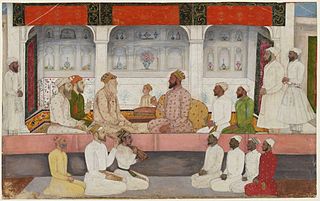
Bajirao I, born as Visaji, was the 7th Peshwa of the Maratha Empire. He after Shivaji, is considered to be the most charismatic and dynamic leader in Maratha history. He was just twenty years old and already had a reputation for rapid decisions and a passion for military adventure.

The Maratha Confederacy, also referred to as the Maratha Empire or the Maratha Kingdom, was an early modern polity in the Indian subcontinent comprising the realms of the Peshwa and four independent Maratha chiefs who were often subordinate to the former. It was formed in 1674 with the coronation of Shivaji of the House of Bhonsle as the Chhatrapati of the Marathas. The Maratha realm was recognised by Bahadur Shah I, the Shahenshah of Hindustan as a tributary state in 1707 after a prolonged rebellion. The Marathas continued to recognise the Shahenshah as their nominal suzerain similar to other contemporary Indian entities.

Mir Qamar-ud-din Khan Siddiqi also known as Chin Qilich Qamaruddin Khan, Nizam-ul-Mulk, Asaf Jah and Nizam I, was the first Nizam of Hyderabad. He was married to the daughter of a Syed nobleman of Gulbarga. He began his career as a favourite of the Mughal emperor Aurangzeb, who made him a general. Following the death of Aurangzeb in 1707, Asaf Jah refused to favour any one of Aurangzeb's warring sons and as such remained neutral. When Aurangzeb's third son Bahadur Shah ultimately emerged victorious, Asaf Jah was rotated as governor of multiple Mughal provinces until 1714, when he was created Viceroy of the Deccan with authority over six Mughal provinces in southern India from 1714 to 1719. From 1719 onwards he was involved in combating the intrigues of the Sayyid Brothers. From 1720 to 1722 he helped the new Mughal emperor Muhammad Shah eliminate the Sayyed brothers and was rewarded by being elevated to the grand viziership from 1722 to 1724.

Peshwa was second highest office in the Maratha Confederacy, next in rank and prestige only to that of the Chhatrapati. Initially serving as the appointed prime minister in the Maratha empire, the office became hereditary after the death of Shahu in 1749. During the reign of Shahu, the office of Peshwa grew in power and the Peshwas came to be the de facto rulers of the Maratha empire. However following the defeat of the Marathas in 1761, the office of the Peshwa became titular as well and from that point onwards served as the ceremonial head of the Confederacy underneath the Chhatrapati.

Balaji Baji Rao, often referred to as Nana Saheb I, was the 8th Peshwa of the Maratha Confederacy. He was appointed as Peshwa in 1740 upon the death of his father, the Peshwa Bajirao I.

Sawai Jai Singh II, was the 29th Kachwaha Rajput ruler of the Kingdom of Amber, who later founded the fortified city of Jaipur and made it his capital. He became the ruler of Amber at the age of 11, after the death of his father, Mirza Raja Bishan Singh, on 31 December 1699.

Shahu I was the fifth Chhatrapati of the Maratha Empire founded by his grandfather, Shivaji I. He was born into the Bhonsle family, and was the son of Sambhaji I and Yesubai. At a young age, he was taken into custody at the Siege of Raigad by Mughal emperor Aurangzeb, and held captive by the Mughals. He was released from captivity after the death of Aurangzeb in the hope of engineering an internecine struggle among the Maratha factions of Tarabai and Shahu. Raja Shahu emerged victorious in the bloody Battle of Khed and was crowned as Chhatrapati.

Chhatrasal Bundela was the Raja of Panna from 1675 to 1731. He is well known for his Resistance against the Mughal Empire.

Malhar Rao Holkar was a noble subedar of the Maratha Empire, in present-day India. He was one of the early officers along with Ranoji Scindia to help spread the Maratha rule to northern states and was given the estate of Indore to rule by the Peshwas, during the reign of the Maratha emperor Shahu I. He was founder of the Holkar dynasty that ruled Malwa.
The Battle of Patan was fought on 20 June 1790 between the Maratha Kingdom of Gwalior supported by the Peshwa & Holkar and the alliance formed by the Rajput Kingdoms of Amber, Kingdom of Marwar supported by Mirza Ismail Beg who betrayed Mahadji and joined the Rajput army in exchange for a promise of money. The battle resulted in a decisive Maratha victory.

Ranoji Shinde was the founder of the Scindia dynasty, a Maratha clan that produced outstanding Maratha military commanders during the 18th century. Later the Scindia served as vassals of the British from the northern Princely state of Gwalior.
Ranoji Bhoite was a Maratha chieftain of the Bhoite clan who lived in the 18th century. The Commander in Chief of the Maratha army from satara He was a contemporary of Ranoji Shinde, Dattaji Shinde, and others. Bhoite was an active Commander in Maratha's North India Campaign. Some Maratha leaders survived after the Panipat battle and created their own kingdoms, but Bhoite did not. He served under King Shahu in the Satara Kingdom.
Originally Chavhan which is written as Chavan by some people is a clan mostly found in rajput and Maratha, largely found in Maharashtra, India, and neighbouring states.

The Battle of Shakar Kheda took place on 11 October 1724 at (Fathekheda) in Berar and 350 kilometres from Aurangabad between Nizam-ul-Mulk and Mubariz Khan, Subedar of the Deccan.

The Maratha invasion on Awadh in 1737, led by Peshwa Bajirao and Malhar Rao Holkar, involved campaigns such as Malhar Rao's invasion of Bhadawar, a Rajput vassal of the Mughal Empire, resulting in the Battle of Jalesar. Nawab Saadat Ali Khan of Awadh defeated Malhar Rao at Jalesar, compelling the Marathas to retreat. Subsequently, Bajirao raided Delhi, the Mughal capital, defeating a Mughal contingent at the outskirts but withdrawing upon the approach of Vizier Qamaruddin Khan.

The Battle of Balapur marked a civil conflict among Mughal leaders, triggered by the uprising of the Sayyid Brothers. This uprising led to a decline in the status of other Mughal leaders.

The Maratha invasion of the Deccan in 1739, led by Peshwa Bajirao I, was a military campaign of the Maratha Empire against the Nizam of Hyderabad. Bajirao's Maratha forces invaded Hyderabad's territories and had a military conflict with Nasir Jung, the son of Nizam-ul Mulk, Asaf Jah.
The Treaty of Bhopal was an agreement signed in 1738 following the Battle of Bhopal, which took place on December 24, 1737. The battle pitted the Maratha Confederacy led by Peshwa Baji Rao I against a combined force of the Nizam of Hyderabad, the Subahdar of Bhopal, and other Mughal vassals.
Battle of Sindhkhed also known as Siege of Sindhkhed was an Indian battle fought in 1757 between Maratha forces under Vishwasrao against Nizam Ali where Marathas defeated the Nizam Army and Nizam sued for peace.

Bajirao's Konkan campaign usually referred as Janjira campaign or Janjira War














